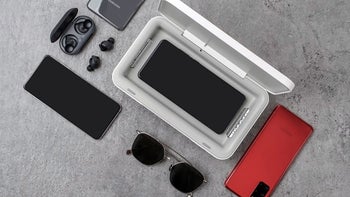Samsung's new UV light phone sterilizer comes in time for the next coronavirus wave
We may earn a commission if you make a purchase from the links on this page.

Heretofore obscure UV sanitizers are having a filed day with the coronavirus pandemic raging, as hospitals and households alike are buying the machines that kill almost all disease-causing elements on the surface of, well, everything.
It, however, depends on whether you have contact with people that carry the COVID-19 strain and common surfaces they may have touched with unwashed hands or sneezed on. You can then pick up the germ unwittingly, and smear it all over your handset with usage.
How long it stays there depends on the case material, too, as per the new "Aerosol and surface stability of HCoV-19 (SARS-CoV-2) compared to SARS-CoV-1" research (PDF) posted in The New England Journal of Medicine (NEJM).
Here's how long can the coronavirus last on your phone display surface, frame, or stay on your case (at 68 degrees):
As you can see, detectable traces of the HCoV-19 coronavirus strain can stay on phone's surfaces for days, so word to the wise - clean, sanitize, disinfect your handset as often as you can if you have contact with coronavirus carriers or areas where it is present.
From UV-beaming robots driving themselves from a hospital room to a hospital room to sterilize the premises, to UV phone sanitizers, these sunlight replacements are all the rage right now, to the extent that the most popular ones were sold out a few weeks into the lockdown.
Samsung outs UV light phone sanitizer but not just for Galaxy phones
Enter Samsung and its manufacturing prowess. After helping the famed Korean Covid-19 test producers to ramp up productivity and output with its manufacturing best practices, the company is now on to providing you a fast and easy way to sanitize your phone upon entering the house.
According to Samsung, "the UV Sterilizer features dual UV lights that sterilize both the top and bottom surface of items that are placed inside. It also boasts a sleek and minimal design, allowing you to store your UV Sterilizer anywhere in the house – from the bedroom to the living room – without it looking out-of-place." Is it so? Well, judge the design for yourself.
Besides disinfecting your phone, you can also throw your earbuds, glasses and other accessories in Samsung's new UV sterilizer, as it is plenty large to accomodate any paraphernalia you carry outside and all display sizes.
The new UV Sterilizer with Wireless Charging is made by Samsung C&T, a partner of the Samsung Mobile Accessory Partnership Program(SMAPP), and, as the name suggest, can also wirelessly charge your handset while sterilizing it. It will be available in online and retail stores "from June" for a price that is yet to be printed by Samsung.
For the UV Sterilizer, Samsung asked two independent test and certification institutes, Intertek and SGS, to certify that it can effectively kill up to 99% of bacteria and germs, including E. coli, Staphylococcus aureus and Candida albicans. Not that these claims differ from the ones each and every UV light sterilizer on Amazon gives, of course, but this is the first such machine from a reputable brand like Samsung that has the certification to back up the claims in the description.
Does your phone's surface really present a coronavirus threat?
The answer is not on its own, as germs are always languishing there for your immune system to take care of, while the COVID-19 virus is mainly transmitted by infected people shedding it when they talk, cough, sneeze, cry or sing, but you can never be too careful with these things.
It, however, depends on whether you have contact with people that carry the COVID-19 strain and common surfaces they may have touched with unwashed hands or sneezed on. You can then pick up the germ unwittingly, and smear it all over your handset with usage.
How long it stays there depends on the case material, too, as per the new "Aerosol and surface stability of HCoV-19 (SARS-CoV-2) compared to SARS-CoV-1" research (PDF) posted in The New England Journal of Medicine (NEJM).
- 2-3 days on glass, metal and ceramics
- Up to 5 days on plastics
- Up to 4 days on wood
- Less than 8 hours on latex
- 2-8 hours on aluminum
- 13 hours on steel is the median half-life estimate for HCoV-19
- 16 hours on polypropylene
As you can see, detectable traces of the HCoV-19 coronavirus strain can stay on phone's surfaces for days, so word to the wise - clean, sanitize, disinfect your handset as often as you can if you have contact with coronavirus carriers or areas where it is present.










Things that are NOT allowed: